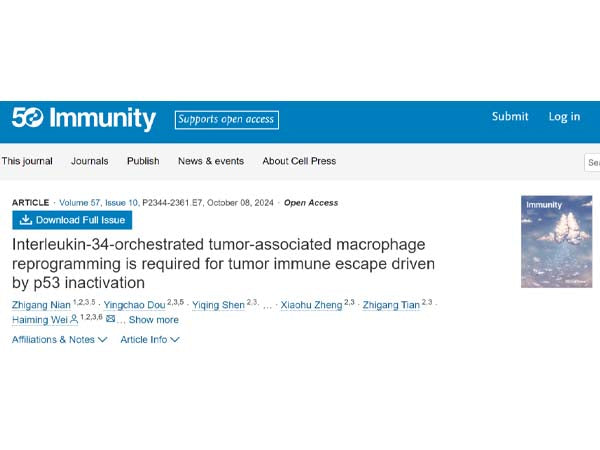Absin multiplex fluorescence immunohistochemistry helps unravel tumor immune escape mechanisms

Tumor-associated macrophages (TAMs) play a complex and critical role in the study of tumor microenvironment (TME). They are not only involved in the occurrence and development of tumors, but are also closely related to the immune escape of tumors. At the Key Laboratory of Immunomodulation and Immunotherapy of the Department of Life Science and Medicine of the University of Science and Technology of China, Professor Wei Haiming's research group has recently made a major scientific breakthrough. They published a research paper titled "Interleukin-34-orchestrated tumor-associated macrophage reprogramming is required for tumor immune escape driven by p53 inactivation" in the journal Immunity using the Absin Multiplex Fluorescence Immunoassay Kit. This study not only reveals the key mechanism of how p53 protein mutations promote tumor immune evasion, but also provides new potential targets for liver cancer treatment. The use of absin multiplex fluorescence immunohistochemistry (mIHC) provides us with a new perspective on the role of TAMs in tumor immune evasion.

Breakthrough discovery: the important role of IL-34 in p53-inactivated tumors
The research team found that cancer stem cells (CSCs) secrete large amounts of IL-34 in tumors with loss of p53 function. This cytokine drives M2-type polarization of TAMs via the CD36 axis, forming foam-like macrophages that accumulate in Trp53/tumors and work with CSCs to promote tumor immune evasion.

Technical Highlights: ABSIN Multiplex Fluorescence Immunohistochemistry Technology
In this study, the multiplex fluorescence immunohistochemistry technology provided by ABSIN played a key role. With this technique, researchers are able to detect multiple markers simultaneously on the same tissue section, allowing for precise identification and characterization of TAMs. Specifically, the researchers used antibodies against EPCAM, COL4A2, CTGF, FSTL1, and COL1A2, which together define F5-CAFs, a specific subset of TAMs. Through this multicolor labeling method, the researchers revealed the spatial distribution of F5-CAFs in tumor tissues and co-localized with EpCAM, a marker of cancer stem cell characterization.

Significant clinical relevance: F5-CAFs are associated with poor prognosis
The results suggest that the abundance of F5-CAFs is associated with a poor prognosis in patients with hepatocellular carcinoma (HCC). Using mIF technology, the researchers analyzed the tumor tissues of 92 HCC patients and found that the proportion of F5-CAFs in the tumor stroma was significantly correlated with the survival time of the patients. This finding highlights the important role of F5-CAFs in tumor development and provides a potential target for future therapeutic strategies.
Conclusion: Immunotherapeutic potential targeting F5-CAFs
This study not only revealed the mechanism of action of p53 inactivation in tumor immune evasion, but also pointed to F5-CAFs as potential immunotherapeutic targets. By blocking the IL-34 signaling pathway, the researchers observed a significant inhibition of Trp53/tumor growth, which provides strong evidence for the development of new cancer treatment strategies.
Overall, the application of ABSIN multiplex fluorescence immunohistochemistry in this study not only improves our understanding of the heterogeneity of TAMs in the tumor microenvironment, but also provides a new perspective for the diagnosis and treatment of cancer. With a better understanding of cellular interactions in TME, we are expected to develop more effective immunotherapy strategies to improve the prognosis of cancer patients.
Recommended hobbies:

|
Catalog number |
Product name |
specification |
|
Seven-color multiplex fluorescence immunohistochemistry staining kit (pika universal secondary antibody) |
20T/100T |
|
|
Seven-color multiplex fluorescent immunohistochemistry staining kit (plus) (pika universal secondary antibody) |
20T/100T |
|
|
Seven-color multiplex fluorescent immunohistochemical staining kit (anti-rabbit secondary antibody) |
20T/100T |
|
|
Seven-color multiplex fluorescent immunohistochemistry staining kit (plus) (anti-rabbit secondary antibody) |
20T/100T |
|
|
Six-color multiplex fluorescent immunohistochemistry staining kit (pika universal secondary antibody) |
20T/100T |
|
|
abs50049 |
Six-color multiplex fluorescent immunohistochemistry staining kit (plus) (pika universal secondary antibody) |
20T/100T |
|
Six-color multiplex fluorescent immunohistochemical staining kit (anti-rabbit secondary antibody) |
20T/100T |
|
|
abs50048 |
Six-color multiplex fluorescent immunohistochemical staining kit (plus) (anti-rabbit secondary antibody) |
20T/100T |
|
Five-color multiplex fluorescent immunohistochemical staining kit (pika universal secondary antibody) |
20T/100T |
|
|
Five-color multiplex fluorescent immunohistochemical staining kit (anti-rabbit secondary antibody) |
20T/100T |
|
|
Four-color multiplex fluorescent immunohistochemical staining kit (pika universal secondary antibody) |
20T/100T |
|
|
Four-color multiplex fluorescent immunohistochemical staining kit (anti-rabbit secondary antibody) |
20T/100T |
|
|
abs50086 |
Two-color multiplex fluorescent immunohistochemical staining kit (anti-rabbit secondary antibody) |
100T |
|
abs50087 |
Two-color multiplex fluorescent immunohistochemical staining kit (pika universal secondary antibody) |
100T |
|
abs50088 |
Three-color multiplex fluorescent immunohistochemical staining kit (anti-rabbit secondary antibody) |
100T |
|
abs50089 |
Three-color multiplex fluorescent immunohistochemical staining kit (pika universal secondary antibody) |
100T |
|
abs50083 |
Lung Cancer Tumor Microenvironment Multiplex Fluorescence Immunohistochemistry Assay Kit(I) |
20T |
|
abs50084 |
Lung Cancer Tumor Microenvironment Multiplex Fluorescence Immunohistochemistry Assay Kit (II) |
20T |
|
Antibody eluent (for mlHC) |
30mL |
|
|
abs9860 |
Tissue autofluorescence quencher |
20mL |
|
Multicolor related reagents |
Catalog number |
Product name |
specification |
|
fixed |
4% paraformaldehyde (general purpose tissue fixative solution) |
500mL |
|
|
Embedding (frozen samples) |
abs9756 |
OCT embedding medium |
110mL |
|
Antigen retrieval (paraffin sections) |
abs9342 |
Tris-EDTA antigen retrieval solution (10×, pH 9.0) |
100mL |
|
abs9248 |
Sodium citrate antigen retrieval solution (50×) |
100mL |
|
|
Antibody elution (samples that cannot be eluted with thermal repair, e.g., cells, frozen, bone tissue, etc.) |
Antibody eluent (for mIHC) |
30mL |
|
|
Cell permeabilization (required for intracellular indicators) |
abs9149 |
Quraton X-100 |
100mL |
|
Quenching endogenous peroxidases |
abs9333 |
Peroxidase blocking solution (H2O2 method) |
100mL |
|
Blocking (secondary antibody same source serum) |
Goat serum |
50mL |
|
|
abs9157 |
Bovine serum albumin |
100g |
|
|
Poly HRP secondary antibody |
abs20148 |
Goat anti-Rabbit and Mouse IgG(H+L) |
5mL |
|
abs20173 |
Goat anti-Rabbit IgG (H+L) |
5mL |
|
|
Antibody diluents |
abs9299 |
Primary and secondary antibody diluents |
100mL |
|
Buffer |
abs952 |
TBST(10×) |
500mL×2 |
|
abs9340 |
PBST(1×,pH7.4) |
500mL |
Absin provides antibodies, proteins, ELISA kits, cell culture, detection kits, and other research reagents. If you have any product needs, please contact us.
|
Absin Bioscience Inc. Email: worldwide@absin.net |
 Follow us on Facebook: Absin Bio Follow us on Facebook: Absin Bio |




